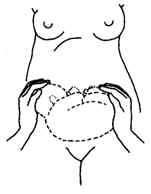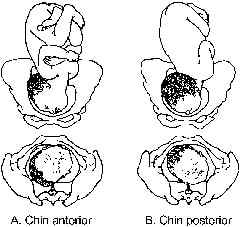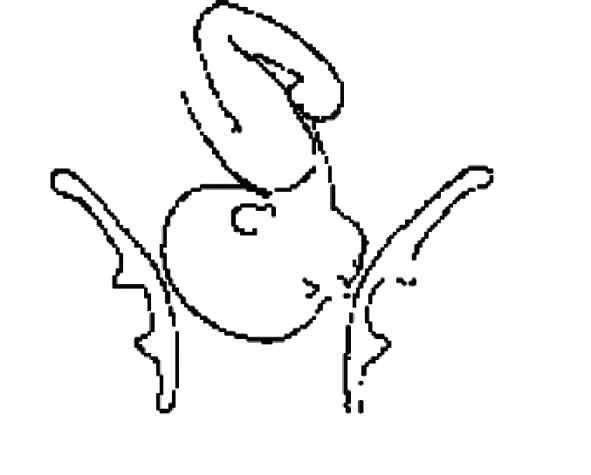This refers to all presentations of the fetus ( i.e., face, breech, brow, etc.) other than the vertex.
Predisposing factors for malpresentations are the following:
1) Maternal factors:
- Contracted pelvis (narrow pelvis).
- Pendulous abdomen( relaxed uterus).
- Pelvic tumours: fibromyomas, ovarian tumors.
- High parity.
- Polyhydramnios / oligohydramnious.
- Previous uterine scar.
2) Fetal factors:
- Prematurity.
- Fetal attitude.
- Fetal anomaly (i.e., hydrocephalus, anencephalus).
- Multiple pregnancy (more than one fetus in the uterus).
The clinical assessment (physical examination) is usually diagnostic. Especially, in labour with dilated cervix, the vaginal examination provides adequate information.
Breech Presentation
Breech presentation is when the buttock or the lower extremity of the fetus is found in the lower pole of the uterus and cephalic pole of the fetus in the uterine fundus. Most common malpresentation is discovered before labour. Breech presentation is much more common in premature labour.
Types of breech presentation (figure 6.1):
- Frank breech: both hips are flexed while both knees are extended. Neither of the feet is felt.
- Complete breech: both hips and knees are flexed. If the feet are felt, they are placed above the buttock.
- Footling breech: one or both hips are extended with one or both extended knee(s), and the foot felt below the buttocks
- Kneeling breech: one or both knee(s) are extended with flexed knee(s) and the knee felt first to bellow the breech

Figure 6.1. Types of breech presentation.
Complications of breech presentation:
- The fetal head gets stuck (arrested) before delivery.
- Obstructed when the fetus is disproportionately large for the size of the maternal pelvis.
- Cord prolapse.
- Premature separation of the placenta (placental abruption).
- Birth injury to the baby, e.g. fracture of the arms or legs, nerve damage.
- Trauma to the internal organs, spinal cord damage.
- After coming head.
Management:
- Identify cases and refer to a higher health facility.
Transverse Lie
When the fetus is positioned with the head on one side of the pelvis and the buttocks in the other (transverse lie), vaginal delivery is impossible as indicated in the figure below.

Fig. 6.2. The transverse lie.
Cause of transverse lie:
Maternal factors
- Laxity of abdominal and uterine muscles.
- Uterine abnormality.
- Contracted (abnormally narrow) pelvis.
Fetal factors
- Preterm labour.
- Multiple pregnancies.
- Polyhydramnios.
- Placenta previa.
Complications:
- Cord prolapsed.
- Trauma to a prolapsed arm.
- Obstructed labour and ruptured uterus.
- Fetal hypoxia and death.
Management:
- Identify cases and refer to higher health institutions
Face Presentation
The face presents with the complete extension of the fetal head. With adequate pelvic size and rotation of the head to the mento-anterior position, vaginal delivery should be achieved after a long labour. The fetal head stays between full extension and full flexion so that the biggest diameter (the mento-vertex) presents (Figure 6.3. below).

Figure 6.3. Different face presentations.
Causes of face presentation:
- Abnormal shape of the mother's pelvis.
- Laxity of the uterus after many previous full-term pregnancies.
- Twine pregnancy
- Excessive amniotic fluid.
- Congenital abnormality of the fetus (e.g. anencephaly, which means no or incomplete skull bones).
Complications:
- Obstructed labour and ruptured uterus
- Cord prolapsed
- Facial bruising
- Cerebral haemorrhage (bleeding inside the fetal skull).
Management:
- Identify cases and refer to higher institutions.
Brow Presentation
Brow presentation is a partially deflexed head, usually only diagnosed once labour is well established. The anterior fontanelle and super orbital ridges (sinciput) are palpable on vaginal examination. Unless the head flexes, a vaginal delivery is not possible, and a caesarian section is required (Figure 6.4).

Figure 6.4. Brow presentation.
Causes of Brow presentation:
- Lax uterus due to repeated full term pregnancies.
- Multiple pregnancy.
- Polyhydramnios.
- Abnormal shape of the mother's pelvis.
Complications:
- Obstructed labour and ruptured uterus.
- Cord prolapsed.
- Facial bruising.
- Cerebral haemorrhage.
Management:
- Identify cases and refer to higher health institutions.




